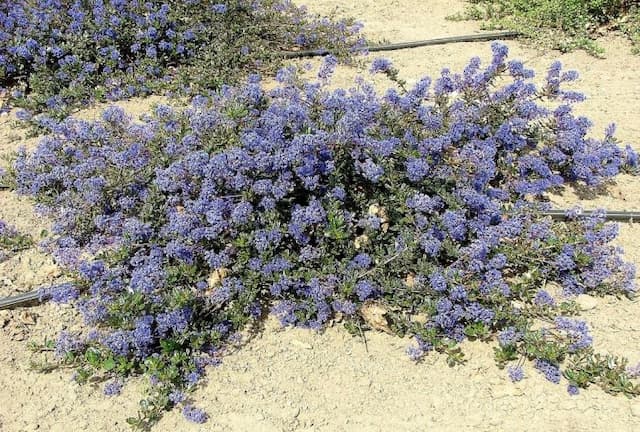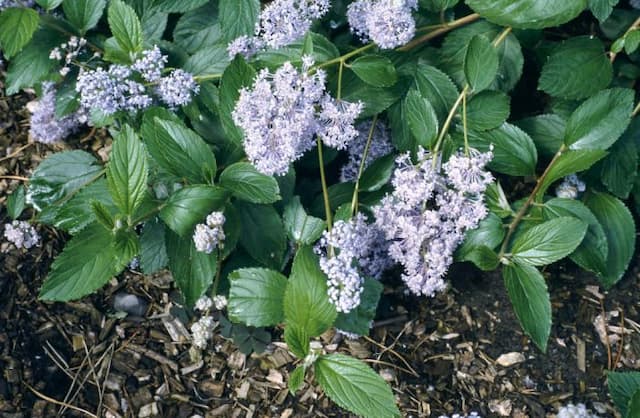California Lilac Ceanothus 'Concha'

ABOUT
The Ceanothus 'Concha', commonly known as California Lilac, boasts a stunning display of deep blue flowers that bloom profusely in dense clusters, creating a vibrant and eye-catching scene. The blossoms are tiny, yet their sheer number makes for an impressive display of color. Complementing the vivid blooms, this plant has glossy green leaves that provide a lush backdrop. These leaves are small to medium in size and may have a crinkled texture with a smooth margin. The overall form of the California Lilac is dense and bushy, giving it a full and rounded appearance that exudes vitality and vigor. The branches of the plant can be somewhat stiff with a rich, dark color, providing a striking contrast to both the green foliage and the blue flowers. As a popular ornamental, it is highly regarded for its hardiness and the stunning visual interest it adds to gardens and landscapes.
About this plant
 Names
NamesFamily
Rhamnaceae
Synonyms
California Wild Lilac, Concha Ceanothus
Common names
Ceanothus 'Concha'.
 Toxicity
ToxicityTo humans
The California lilac, specifically the Ceanothus 'Concha' variety, is generally not considered toxic to humans. There is no significant evidence indicating that ingestion of the California lilac poses a health risk. Therefore, no common symptoms of poisoning are reported for this plant when it comes to human exposure. However, as with any plant material, individuals may experience varying reactions, and it is advisable to avoid ingesting parts of this plant or any plant that is not known to be safe for consumption.
To pets
The California lilac, or Ceanothus 'Concha', is not widely recognized as a toxic plant for pets either. There is limited information regarding its toxicity, and it does not appear on common lists of plants that are known to be poisonous to domestic animals. However, individual pets may react differently, and ingestion of plant material can sometimes cause mild stomach upset in animals. If you suspect your pet has ingested a large amount of the California lilac and is showing adverse symptoms, it is always best to consult with a veterinarian.
 Characteristics
CharacteristicsLife cycle
Perennials
Foliage type
Evergreen
Color of leaves
Green
Flower color
Blue
Height
6-9 feet (1.8-2.7 meters)
Spread
6-9 feet (1.8-2.7 meters)
Plant type
Shrub
Hardiness zones
8
Native area
North America
Benefits
 General Benefits
General Benefits- Attracts Pollinators: Ceanothus 'Concha' is known to attract bees and butterflies, which are essential for pollination of gardens and ecosystems.
- Drought Tolerance: Once established, it is very drought tolerant, making it ideal for water-conserving landscapes.
- Low Maintenance: It requires minimal care once established, needing little to no irrigation or fertilization.
- Erosion Control: Its root system helps stabilize slopes and can be helpful in preventing soil erosion.
- Year-Round Interest: With its dark green foliage and vibrant blue flowers, it provides visual interest throughout the seasons.
- Fast Growing: It is a fast-growing shrub that can quickly fill in areas of the garden or landscape.
- Habitat Support: Serves as a host plant and provides habitat for various species of wildlife.
- Architectural Structure: The dense bushy habit of the plant provides excellent structure and form for garden designs.
 Medical Properties
Medical Properties- This plant is not used for medical purposes.
 Air-purifying Qualities
Air-purifying QualitiesThis plant is not specifically known for air purifying qualities.
 Other Uses
Other Uses- Landscape Coloring: California Lilac can be used to naturally dye fabrics a range of blue and green shades, depending on the mordant used.
- Photography: The intense blue flowers of California Lilac can provide a stunning backdrop or subject for nature photography.
- Artistic Inspiration: Artists can use California Lilac as a muse for paintings, drawings, and other forms of art due to its vivid color and attractiveness to butterflies.
- Erosion Control: California Lilac's root system helps stabilize slopes and hillsides, preventing soil erosion in landscapes.
- Culinary Decoration: Although not widely known for culinary uses, the blossoms can be used as a decorative garnish in salads and desserts.
- Companion Planting: The plant can be beneficial in a garden as it attracts beneficial insects that can help with the pollination of other plants and control pests.
- Soil Improvement: California Lilac can be used in soil improvement practices as it is believed to have nitrogen-fixing capabilities, enriching soil fertility.
- Privacy Screening: Taller varieties of the California Lilac can be planted to create a natural privacy screen due to its dense foliage.
- Winter Interest: Some types of California Lilac have evergreen foliage, which can add color and interest to a wintertime garden.
- Bonsai: With its attractive flowers and the potential for shaping, California Lilac can be trained as a bonsai plant for enthusiasts of the art form.
Interesting Facts
 Feng Shui
Feng ShuiThe California Lilac is not used in Feng Shui practice.
 Zodiac Sign Compitability
Zodiac Sign CompitabilityThe California Lilac is not used in astrology practice.
 Plant Symbolism
Plant Symbolism- Endurance: The Ceanothus 'Concha', commonly known as California Lilac, is a hardy plant capable of surviving in tough conditions, symbolizing the ability to endure and thrive despite challenges.
- Hope: With its vibrant blue flowers, the California Lilac is often seen as a symbol of hope, conveying a sense of expectation for positive things to come.
- Renewal: Blooming primarily in the spring, the California Lilac represents renewal and the start of new beginnings.
- Patriotism: Its blue flowers can evoke a sense of patriotism, especially within the United States where the color is associated with the national flag.
 Water
WaterTo properly water a California lilac, deep watering is recommended to encourage deep root growth. During the first growing season, water the plant once a week with approximately 2 gallons of water per session. Once established, California lilac is drought-tolerant and will only require watering every two to three weeks, depending on your climate and soil conditions. In very hot and dry weather, monitor the plant for signs of stress, and water accordingly.
 Light
LightThe best light conditions for a California lilac include a spot that receives full sun for at least six hours a day. They thrive under direct sunlight, which helps the plant produce abundant and vibrant blooms. California lilac can tolerate partial shade, but bloom production may be reduced in less than full sun conditions.
 Temperature
TemperatureThe California lilac prefers moderate temperatures and can do well within a typical temperate range. It can survive minimum temperatures down to about 10 degrees Fahrenheit but it is happiest when temperatures remain between 50 to 75 degrees Fahrenheit. It should be protected from extreme heat and frost, which can damage the foliage and impair flowering.
 Pruning
PruningPruning the California lilac is necessary to maintain its shape and to promote healthy growth. The best time to prune is immediately after the blooming season, which is usually late spring or early summer. Remove any dead or diseased branches, trim back overgrowth, and shape the plant as desired. Pruning every year or every other year is generally sufficient.
 Cleaning
CleaningAs needed
 Soil
SoilCalifornia lilac (Ceanothus 'Concha') thrives in well-draining soil with a slightly acidic to neutral pH between 5.5 and 7. A mix of loam, sand, and compost works well, ensuring good drainage to prevent root rot.
 Repotting
RepottingCalifornia lilac is typically planted in the ground and does not require frequent repotting if grown in a container, aim to repot every 2-3 years or when rootbound.
 Humidity & Misting
Humidity & MistingCalifornia lilac prefers moderate humidity but is quite adaptable and can tolerate the lower humidity levels commonly found in most home environments.
 Suitable locations
Suitable locationsIndoor
Place in bright, indirect light with well-draining soil.
Outdoor
Plant in full sun, well-draining soil, water deeply occasionally.
Hardiness zone
7-10 USDA
 Life cycle
Life cycleCalifornia Lilac 'Concha' begins its life as a seed, which when sown and under the right conditions, germinates and produces a small seedling. The seedling grows into a young plant through a vegetative stage characterized by rapid foliage growth. This is followed by the establishment phase, where the plant develops a strong root system and woody stems, becoming more resilient to environmental stress. The mature California Lilac 'Concha' reaches the reproductive stage, producing clusters of deep blue or violet flowers that are highly attractive to pollinators. After pollination, the flowers develop into fruit that contain seeds, completing the cycle. As a perennial shrub, California Lilac 'Concha' can repeat this cycle for many years, typically living up to 20-25 years in ideal conditions.
 Propogation
PropogationPropogation time
Spring to early summer
The most popular method for propagating California Lilac 'Concha' is through semi-hardwood cuttings. Typically, the best time to take these cuttings is in late summer to early fall when the current year's growth has begun to mature and harden off. Cut a 4 to 6 inch (approximately 10 to 15 cm) long piece of stem that has several sets of leaves, making sure to cut just below a node, where the leaf joins the stem. Remove the leaves from the lower half of the cutting and dip the cut end into a rooting hormone to encourage root development. Then, place the cutting into a pot filled with a well-drained soil mix, ensuring that at least one node is below the soil surface where roots can form. It's important to keep the soil consistently moist and to provide a warm environment with indirect light until the cutting has rooted, which may take several weeks.









